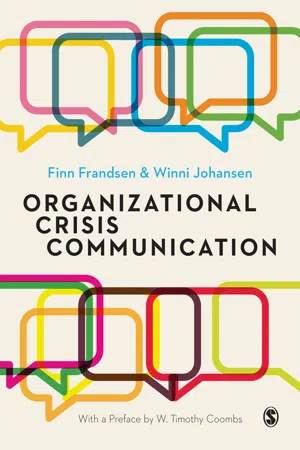Organizational crises can be studied from many different perspectives. In this
part we apply a multidimensional approach exploring the five key dimensions of
the field: (1) the societal dimension, (2) the definitional and typological
dimension, (3) the managerial dimension, (4) the communicative dimension, and
(5) the (inter)cultural dimension. After reading Part 1, the reader
should be able to provide answers to the following questions:
Signs of a crisis society
A first sign of the emergence of a crisis society is the fact that we have started using the word crisis much more frequently than before. One way to verify this is to examine the appearance and frequency of keywords from the crisis terminology as reflected in the news media. While concepts such as crisis management and crisis communication have been in use for a long time in pioneering countries such as the United States and France, this is not the case in, for example, Denmark and Japan (West, 2006). We carried out an analysis of the frequency of the words crisis, crisis management, and crisis communication in three Danish newspapers (Jyllands-Posten, Politiken, and Børsen) from 1990 to 2010, that is until the effects of the global financial crisis were being felt everywhere and where we expected that the word crisis would become omnipresent. The results of this analysis showed that there is a clear increase in the use of words such as crisis starting in the mid-1990s. From 1990 to 1995, crisis is used only 14 times in Jyllands-Posten, the largest newspaper in Denmark. However, from 1996 to 2000, it is used 7,281 times. From 2001 to 2005, it appears 7,043 times, and from 2006 to 2010, it is used 17,888 times (in the same newspaper). Regarding more technical terms such as crisis management plan (CMP), crisis management team (CMT), crisis management, and crisis communication, these do not appear until the late 1990s and early 2000s (see Figure 1.1). In Jyllands-Posten, crisis management is used for the first time in 1997, and crisis communication in 2002.
In the two other Danish newspapers, Politiken and Børsen, we found similar patterns in the frequency of these terms.
In Discourse and Social Change (1992), British critical discourse analyst Norman Fairclough explains how social changes are reflected in our use of language. According to Fairclough, important areas of our society such as higher education have been subjected to marketization, which is reflected in our discourse on higher education when we refer to educational programs as ‘products’ and to students as ‘clients’ (Fairclough, 1993). Similarly, our use of terms such as crisis management and crisis communication reflects new and important developments in society.
Figure 1.1 Frequency of crisis terminology in Jyllands-Posten (1990–2010)
A second sign that we are living in a crisis society is the importance we ascribe to crises. Seeger et al. (2003) claim that crises such as the Titanic disaster, the Exxon Valdez oil spill, the Chernobyl nuclear disaster, the Space Shuttle Challenger explosion, and the 9/11 terrorist attacks are life-changing occurrences that have become archetypical events for both individuals and communities. These crises have transformed into ‘social icons, around which broader meaning is constructed, maintained, symbolyzed and conveyed’ (p. 6).
Once again we can bring in the news media if we want to verify that certain crises have become social icons. Every time we remember a crisis that has acquired the status of a social icon in society at large – a year, 5 years, 10 years, 20 years, or more after the crisis took place – the media cover the event. This may be to illustrate that the aftermath of the crisis has still not reached its final conclusion (an investigation, a trial in the courts, etc.). It may be in order to tell the personal stories of the people who survived a disaster, or of those who were left behind. Or it may be in order to evaluate the consequences of the crisis from a larger historical perspective (see case example 1.1 on the MS Estonia disaster).
A third sign that we are living in a crisis society is the widespread idea (or should we say feeling?) that the number of crises is constantly increasing and that we must handle and investigate these crises. In 2003, we conducted a survey among private companies and public authorities in Denmark (cf. the general introduction). Our aim was to study how the two populations perceived and defined crises, how many crises they had experienced, how they practised crisis management and crisis communication, and how they evaluated their learning needs (Frandsen & Johansen, 2004). As part of the study, 18 follow-up interviews were conducted in which the interviewees were asked the question: Are there more crises today than before? The majority answered yes. However, those who answered yes justified their answer in two different ways. Some gave an ‘objective’ explanation claiming that society has developed in such a way that there are in fact more crises today than before. Others gave a more ‘subjective’ explanation claiming that we have become more aware or conscious of crises, but without postulating that this also meant that there are more crises today than before.
So how can we explain – using social changes as our starting point – that we talk more and more about crises, that we define them as social icons, and that we imagine that there are more crises today than ever before?
Case example 1.1 The MS Estonia disaster as a social icon
On September 28, 1994, the MS Estonia, a 155 meter long and 24 meter broad cruise ferry with a capacity of 2,000 passengers, sank in the Baltic Sea on its way from Tallinn to Stockholm. In all, 852 people lost their lives, including more than 500 Swedes. Only 137 survived. The investigation following the disaster revealed that the locks on the bow door had failed from the strain of the waves and that the door had separated from the rest of the vessel.
The day of the wreck of MS Estonia, a maritime disaster described as the worst ever in Scandinavia, has over time become a day of commemoration that is covered by the news media in many of the countries affected. From 1994 to 2014, for example, Dagens Nyheter (DN), one of Sweden’s largest newspapers, wrote 257 articles about the disaster. The majority were published after the fatal night in September 1994.
Ten years after the disaster, DN released seven articles during the days immediately before and after September 28. The headlines of the articles read: ‘Create clarity about MS Estonia’ (September 29, 2004), ‘Estonia commemorates the victims of MS Estonia’ (September 29, 2004), ‘Evocative commemoration of the victims of MS Estonia’ (September 28, 2004), ‘Survivors talk about ferry disaster’ (September 27, 2004), ‘Swedish parliament releases report on MS Estonia’, ‘Risk of a new disaster’ (September 19, 2004) and ‘MS Estonia archive opens today’ (August 31, 2004).
Twenty years after the disaster, DN released two further articles. The first one, entitled ‘The unthinkable is not impossible’ (September 28, 2014), was about how new equipment had turned the Baltic Sea into a safer workplace for emergency crews, but that it has been difficult to draw a more general lesson from the disaster. The second article, ‘About MS Estonia. Commemorative music that will not settle down’ (September 29, 2014), was about a memorial concert at the Baltic Festival where Finnish composer Jaakko Mäntyjärvi’s choral work ‘Canticum Calamitatis Maritimae’ from 1997 was performed.
Several Danish and Norwegian newspapers also covered the disaster at that time. One of the Danish newspapers contained the article ‘MS Estonia comes back to haunt us’ (BT, September 29, 2014). Another Danish newspaper’s headline read: ‘The disaster that changed Sweden’ (Jyllands-Posten, September 29, 2014). In the latter article, a Swedish professor of political science claimed that the MS Estonia disaster had changed the Swedish national character.
This case example demonstrates how history not only belongs to the past, but also is remembered in the present (Connerton, 1989), and how the MS Estonia disaster has become a social icon in the media. There is a big difference in media coverage in 2004 when attention is focused on the victims, the survivors, and the investigation, and that in 2014 when attention is focused on how this tragic event has changed the Swedish national character.
Risk sociology
The societal dimension of organizational crises, crisis management, and crisis communication is the least researched of the five key dimensions forming the multidimensional approach which gives structure to Part 1 of this book. The majority of scholars in this field have not been interested in studying the development toward a crisis society. Some scholars are satisfied with claiming that the number of crises has increased or that a new type of crisis has emerged. This applies to Mitroff (2004), who in his history of crises talks about the ‘rise of abnormal accidents’. Other scholars provide very brief sociological explanations. This applies to Ogrizek and Guillery (1997) who identify three sets of factors that can explain why we are experiencing more crises today: (1) the influence of the media, (2) the products and production procedures of the industrial society, and (3) a lower psychological and ethical level of tolerance among citizens.
It is not just interesting but necessary to include the societal dimension in the study of organizational crises, crisis management, and crisis communication. The fact that the number of crises has increased – or the belief that this is the case – does not come about by chance or coincidence. Neither is the case that business managers are less competent or fortunate when handling crises today. That the number of crises seems to have increased is the result of a series of important transformations that have taken place, and still are taking place, at various levels in society. A theoretical understanding of these transformations and the new type of society they produce will help illustrate why we are living in a crisis society.
We claim that it is within risk sociology, that is the study of how society organizes in response to risk, that we will find an explan...


